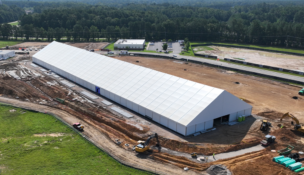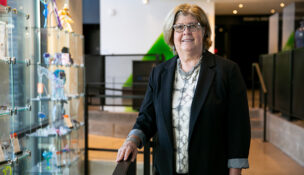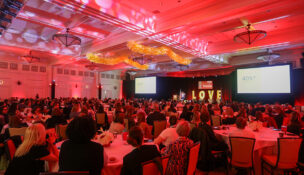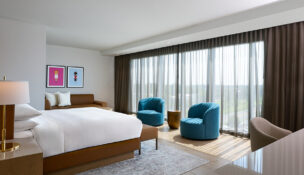A fine wine time
Virginia wineries help draw tourists to Virginia’s resorts and vice versa
A fine wine time
Virginia wineries help draw tourists to Virginia’s resorts and vice versa
As an executive with Philip Morris International, John Higgs traveled throughout Eastern Europe, opening factories for his employer. At one point, he lived among the vineyards of Switzerland.
After he retired, Higgs’ life came full circle when he returned to his native Fishersville to open a winery on family land where his father used to grow apples.
Higgs said he bought the former St. James Orchard from his sister in 2004. The land had lain fallow for 30 years, and the property’s old apple shed was infested with raccoons. “This was a jungle when I bought it,” Higgs recalls. “It was a labor of love to bring the land back.”
It took four years for Riggs and his wife, Shelby, to clear the land and create Barren Ridge Vineyards in what is an up- and-coming Virginia wine area — the Shenandoah Valley.
Located between the Blue Ridge and Allegheny mountains, the valley has a semi-arid climate of warm days and cool nights, and drier weather provides a good environment for growing grapes. Plus, the area’s rolling hills help drain water away from vines, reducing the chance of disease.
At 1,400 feet above sea level, Barren Ridge gets its name from a weather pattern formed by the proximity of the two mountain ranges that direct rain away from the ridge. Today the 1890s apple barn where Higgs helped his father as a child has been transformed into a winery and a rustic tasting room that preserves the shed’s original structure and wooden beams.
There’s plenty of room for visitors to mingle, or they can duck outside to a patio that offers lush views of the mountains and an 11-acre vineyard. There Higgs has planted varietals such as petit verdot, touriga, merlot, viognier and chambourcin.
The Shenandoah Valley made a good showing in the 2015 Governor’s Cup competition of the 12 best wines in Virginia, with three wines making the list. One of them, Muse Vineyard’s 2009 Clio, a Bordeaux-style blended red, took home the top award. Of the 390 entries, Barren Ridge’s 2010 Meritage was a gold cup medalist in the competition for the second year in a row, although it did not make the prestigious Governor’s Case. Its 2009 Meritage was a case selection in 2014.
Located four miles from Interstates 64 and 81, the winery draws tourists traveling through the Shenandoah Valley. “We haven’t quite reached the tipping point where people are coming to the Shenandoah Valley to buy the wines. A lot of people are going to Charlottesville or Staunton and visiting us on the way,” says Higgs.
Of the more than 250 wineries in Virginia now, about 26 are located in the Valley. Last year, they produced 268 tons of grapes from 110 acres of vines, according to Virginia’s Wine Board Marketing Office, or about 3 percent of the state’s overall harvest of 8,600 tons.
Virginia’s resorts are doing their part to promote Virginia’s wineries. Many offer day trips, wine-tastings and wine packages that encourage patrons to experience the state’s many wineries.
The wineries also are doing their part to become tourist attractions by sponsoring events that appeal to visitors and local residents.
For instance, Bluestone Winery in Bridgewater sponsors live music, ranging from bluegrass to Jimmy Buffet, on the second and fourth Fridays of the month. Winemaker Lee Hartman says locals and people from the nearby mountain resorts of Massanutten and Wintergreen come to enjoy the music and the wine. There’s a $10 cover charge per person, and the events aren’t big money makers. “But it’s a good way to make a name for yourself,” he says, “and it’s a good way to unload a lot of wine.”
Thirty-year-old old Hartman represents a younger generation of Virginia winemakers. The son of Bluestone’s owners, Curt and Jackie Hartman, he grew up in the sprawling home on the hill that now houses the winery’s tasting room. “This room is where I had my 13th birthday party,” says Hartman.
Bluestone began as a hobby for the Hartmans and some friends. They planted their first vines for personal use in 2003 and by 2007 decided to turn the vineyard into a business. The rest of what is now a 22-acre vineyard was planted in 2010, the same year a winery was constructed down the hill from the house. Bluestone began pouring in 2011.
After graduating from nearby Eastern Mennonite College with a history degree, Lee Hartman thought he would return to Europe where he had lived previously. But by then he was hooked on winemaking.
“Everything that you do in winemaking is the culmination of everything you’ve done previously, “ Hartman says. The labor-intensive process of growing grapes, pressing them off, fermenting them, bottling the wine and finally pulling the cork represents a nearly irresistible challenge for Hartman, who enjoys experimenting and consulting with other winemakers.
To show it was serious about making good wine, Bluestone hired wine consultant Michael Shaps, one of the state’s premier winemakers. Today, the winery produces 5,000 cases a year, and it already has racked up some awards. In five years, Bluestone has earned three gold medals in the Virginia Governor’s Cup competition.
Virginia ranks fifth in the nation in its number of wineries, and its profile as a wine destination is rising. “Our guests are always asking about vineyards in our areas,” says Pat Fleshman Burnette, marketing and communications manager for The Boar’s Head in Charlottesville.
There are about 40 wineries within a 35- to 45-minute drive from the resort along the Monticello Wine Trail. Thomas Jefferson’s link to wine — he brought over rootstock from Europe and tried unsuccesfully to grow varietal grapes at nearby Monticello — is a historic tie-in and conversation starter for guests interested in wine or the resort’s wine package.
It includes two night’s accommodations, a welcome gift of a bottle of Virginia wine with a fruit and cheese platter, breakfast, a three-course Virginia wine dinner for two one evening and a self-guided tour to a local winery with two tasting passes. The cost is $777 for double occupancy, with the package running through Oct. 31, although it’s based on availability and would be hard to get during a fall football weekend.
The Boar’s Head also offers complimentary wine-tastings for guests in its gift store where it stocks a large selection of Virginia wines.
At Salamander Resort & Spa in Middleburg, the resort invites local wineries to come in. The resort selects a winery of the month, and winery representatives set up a complimentary wine-tasting on Sundays from 2 to 4 p.m. “That introduces people to the wines. It doesn’t have to be someone staying at the property. We have a lot of locals coming in,” says Salamander’s General Manager Reggie Cooper.
In addition, Salamander sponsors a Virginia food and wine pairing dinner in its cooking studio a couple of times a month. It also provides complimentary transportation to some of the 50 wineries located within 30 minutes of the resort.
Another nod to wine is a two-night Grape Escape Package that, among other perks, includes transportation to three local wineries with complimentary tastings and a picnic lunch from Salamander. Weekday rates begin at $569 per person, per night for single occupancy and $639 per person, per night for double occupancy and are slighty higher on weekends.
Cooper notes that some guests prefer to visit wineries on their way to and from a resort. “Often when people arrive on a Friday and we ask if their drive was easy, about 60 percent will say, ‘we stopped at this winery on the way.’ ”
e















